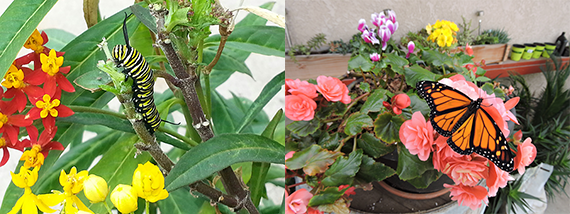
|
(Left) A caterpillar will soon be transformed into a Monarch butterfly after a brief layover as a chrysalis (cocoon), a transformation needed more and more to make up for the dwindling numbers of the stately Monarchs.
(Right) A Monarch with a royal 4?-inch wingspan is the newest resident of Wes Easley’s Santa Paula butterfly garden.
Photos by Wes Easley |
Butterflies are free and it just
takes a few dollars to create a garden
February 27, 2015
By Peggy Kelly
Santa Paula News
Butterflies are free — it just takes a few dollars to stock a garden and other amenities to attract them, as did Wes Easley of Santa Paula, who turned his yard into a Monarch garden.
And his garden has grown with butterflies including a male Monarch with a 4?-inch wingspan that Easley carefully documented from egg to caterpillar to chrysalis to mammoth butterfly.
The proud Easley photographed the big boy after it emerged from its chrysalis (cocoon) last week.
“The main ingredient for a Monarch garden,” to attract the critters as a habitat, “is Asclepsia, commonly known as milkweed.
“The name,” said Easley, “gives it a bad rap as people will destroy it as a weed when in fact it has fantastic flowers and is very hardy.”
He noted “Monarchs only lay eggs on milkweed as it is the sole subsistence of the caterpillar. Its toxic ‘milk’ gives the caterpillar and butterfly a high degree of protection as they will make birds and other predators a bit ill if they eat them.”
The butterfly, he added, “will light on about any flower that produces nectar as that is what they consume.”
In addition to milkweed Easley also has planted salvias and lantana “which the butterflies seem to like. I have 100 or so plants spread out over our front and back yard to attract and feed and I have a nursery of sorts to help the survivability of some while in chrysalis.”
An interesting side note is how hungry Easley found caterpillars to be: “They are voracious and will strip the plants of the foliage but it will grow back.”
Easley is among the growing number of people who have not only become aware of the decline of the Monarch butterfly but also have vowed to help them recover their past population numbers.
“The destruction of milkweed,” including in large amounts by Caltrans, which routinely removed it from roadsides, “helped in the decimation of Monarch numbers. About 20 years ago there was an estimated one-billion Monarchs that migrated to Mexico and a few years ago it was estimated that only 35 million made it.”
Noted Easley of his own effort that is producing an increasing quantity of royal Monarchs, “I’m just trying to help I guess… ”



